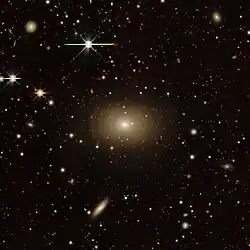| NGC 1989 | |
|---|---|
 legacy surveys image of NGC 1989 | |
| Observation data (J2000 epoch) | |
| Constellation | Columba |
| Right ascension | 05h 34m 2342s[1] |
| Declination | −30° 48′ 03.55″[1] |
| Redshift | 0.035858[1] |
| Heliocentric radial velocity | 10557[1] |
| Distance | 482 Million[2] |
| Apparent magnitude (V) | 12.9[2] |
| Apparent magnitude (B) | 14.13[1] |
| Characteristics | |
| Type | S0[1] |
| Size | 1.40 x 1.1[3] |
| Other designations | |
| ESO 423-21, MCG -5-14-4, AM 0532-304, PGC 17464[2] | |
NGC 1989 (also known as ESO 423-21) is a lenticular galaxy in the Columba constellation. It is about 482 million light-years away from the Milky Way. The galaxy was discovered by John Herschel on January 28, 1835.[4] Its apparent magnitude is 12.9[2] and its size is 1.40 by 1.1 arc minutes.[3]
References
- 1 2 3 4 5 6 "NGC 1989 -- Brightest galaxy in a Cluster (BCG)". SIMBAD. Retrieved 25 November 2017.
- 1 2 3 4 "Galaxy NGC 1989". DSO. Archived from the original on 1 December 2017. Retrieved 25 November 2017.
- 1 2 "Object: NGC 1989 (*)". SEDS. Retrieved 25 November 2017.
- ↑ "NGC 1989 (= PGC 17464)". cseligman. Retrieved 25 November 2017.
External links
 Media related to NGC 1989 at Wikimedia Commons
Media related to NGC 1989 at Wikimedia Commons
This article is issued from Wikipedia. The text is licensed under Creative Commons - Attribution - Sharealike. Additional terms may apply for the media files.